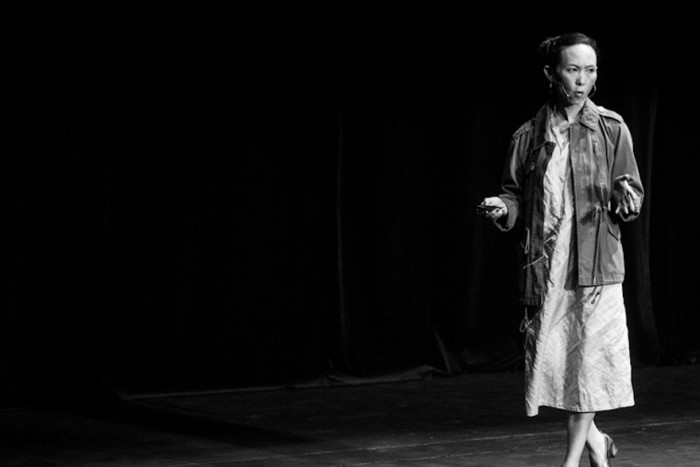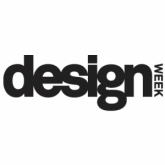
“It’s very hard to explain to people what a graphic designer does,” says Natasha Jen, partner at Pentagram’s New York office. “I think of my role as playing with words, symbols and images. It’s about making things tangible and understandable, and if we can make things delightful – that’s the goal.”
There is a reason Jen, a prolific graphic designer who has created branding, exhibition spaces, installations and more for the likes of Nike and Times Square, is attempting to explain her job. Speaking at this year’s Design Indaba conference in Cape Town, South Africa, she lays bare her thoughts on non-design businesses appropriating what she does every day under a recently-founded term – “design thinking”.
This is not the first time Jen has expressed her rage at this concept; she spoke last year at Adobe’s 99U conference, presenting a talk titled “Design thinking is bullshit”. Since then, Jen has been starting conversations about what this term means, why the rigid process it enforces does not sit well with real-life problems, and why attempting to give everyone a short-course route into design could actually be “extremely dangerous”.
Where does it all come from?
While the idea of looking at how designers think and work has been around since the 1960s, it was David Kelley, founder at design consultancy Ideo, who first adapted the idea of using “design thinking” for business in the 2010s. The concept really started spreading five years ago, after Kelley co-wrote a book called Creative Confidence: Unleashing the Creative Potential Within Us All, released in 2013.
What is “design thinking”?
The problem starts with “design thinking” being an intangible thing that is impossible to describe, says Jen. “I just can’t wrap my head around design thinking, and I ask myself – why can’t I understand it?” she says. “The more I get into it, the more outrageous it appears.”
There is a generic formula applied to the concept, thought. It is normally broken down into five core steps, which are used to tackle any “problem”: empathise, define, ideate, prototype and test. In other words, learn about your target audience, think about key questions that need answering, come up with solutions, build one or more of these solutions, then test them through market research and gain user feedback.
Jen’s first issue with this concept is its simplicity – how can a one-size-fits-all approach be applied to everything? Admittedly, surely there are different considerations that need to be made when creating a corporate marketing campaign for the likes of Coca-Cola, compared to designing a refugee shelter that will be distributed for thousands of people worldwide.
But if we are to follow this five-step process, Jen adds that there is also a crucial step missing that should always sit between prototype and test, which is “design crit” – sitting down in a group and analysing and critiquing a piece of work to improve it before it goes out to the public.
“Presenting to colleagues is really lacking here,” says Jen, exasperated by this point. “We see the same hexagonal diagrams coming up with the same five steps. It’s a very simplistic view that this can solve all problems.”
Why all the sticky notes?
Adding to the vagueness, is the fact that “design thinking” cannot be materialised or represented visually, says Jen. Google the term, and you’ll be affronted with several iterations of coloured hexagons detailed the five process steps, alongside images of groups of people looking thoughtful in an office meeting room, or gathered around a whiteboard covered in coloured sticky notes. What does all this actually mean, asks Jen? If you were to google “logo”, you’d see real brandmarks; or google “exhibition design”, and you’d see interiors of various museums.
“When you only use one little square – a sticky note – as your outlet, that’s a big problem,” she says. “Design needs to use lots of research, photos, images and more to build a more holistic understanding about anything.” Step into a design studio, including Pentagram New York, she adds, and all this evidence will be laid out in the form of a messy office space covered in imagery, text and other inspiration.
Jen also has a problem with the seemingly meaningless vocabulary that comes alongside design thinking, which is “packed with jargon” and “buzzwords”, she says, from “co-creation”, “extreme users”, “radical innovation” and “bodystorming” through to “unlocking” and “unleashing” creative potential – a term coined by the Ideo founder’s infamous book.
“There is a frightening idea of design as this monster you ‘unleash’ to fix the world,” says Jen. “These terms are ridiculous for real designers – we don’t use them to critique our work. If you speak to a designer, we actually use very boring, hard and tangible words – like budget, semantics, the website and typography.”
Learn design for £2.99
This one-size-fits-all approach to design has also led to “design thinking boot-camps”, where people can undertake one or two-day courses on how to think like a designer for a few hundred pounds or dollars. Jen claims she has seen such courses for as little as £2.99, adding that this teaching method is an “extremely dangerous idea” – not only to the design industry, but to education on a whole. “It’s like wanting to become an Olympic athlete without wanting to be trained,” she says.
Additionally, the focus on design as a process rather than having the goal of producing something “beautiful”, is problematic, she says, and undermines design as a skill and craft; in Jen’s eyes, design should perform a function but also be smart, alluring and “delightful”.
Her frustrated comments are spurred by a blog written by Bret Waters, chairman at software development company Tivix, simply titled: “Design thinking is not about design”. It is accompanied by the infamous, five coloured hexagons, too.
“It is quite irresponsible to think that design thinking has nothing to do with how it might manifest in the real world. What’s to say that it shouldn’t have to be beautiful? Beauty is precision and intelligence – not decoration.”
She adds: “This attitude ignores the artistry of craftsmanship and the beauty of culture – the things that elevate our quality of life.”
But shouldn’t we encourage people to embrace design?
While Jen’s humorous cynicism and sarcasm is backed-up with several valid points, there is something to be said for trying to make design more accessible to businesses, and encourage them to think creatively.
There is also an interesting debate about what makes a “proper” design education. Also speaking at this year’s Design Indaba was Tom Dixon, a successful product and furniture designer who did not go to a specialist arts college and is completely self-taught.
Speaking to Design Week, he advocated that universities today are not teaching students enough vocational skills, and that working at furniture brand Habitat was “like [his] university”.
So while this one-size-fits-all approach of “design thinking” filled with meaningless buzzwords cannot responsibly be applied to every project, maybe there is scope to change how the concept is applied and taught to make it more effective. In her talk, Jen herself questions: how can design thinking be improved to make it more effective, beautiful, responsible, and just generally better?
Perhaps employing in-house, trained designers into businesses to teach teams their processes and methods in a skilled way, rather than encouraging people of other professions to “become” a designer in a day, is an option.
Or perhaps, says Jen in her fittingly tongue-in-cheek style, we can use design thinking to try to understand design thinking; she ends her talk with a humorous attempt to decipher it all with a poster she has designed under this very premise. Admittedly, and to her credit, it makes absolutely no sense.











